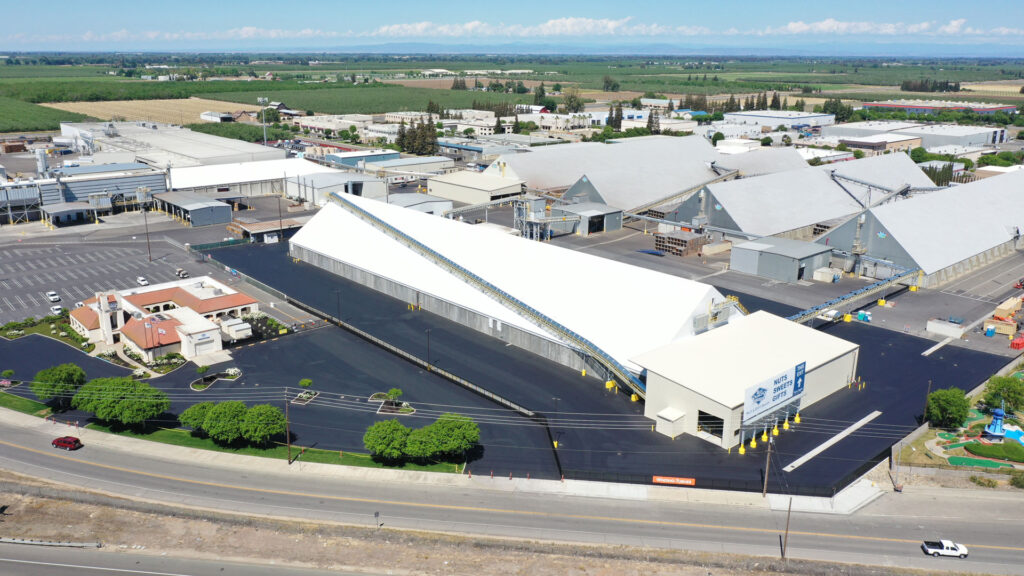
As one of the biggest players in the global almond market, Blue Diamond Growers can rightly credit CEO Mark Jansen for much of its recent success. But, as Jansen shares here, the past 21 months haven’t been easy, and there’s still plenty of work ahead.
Since he arrived as CEO in 2010, Jansen has helped transform Blue Diamond Growers into a $1.75 billion global food manufacturer.
The Sacramento-based cooperative has become the leading shipper of California almonds into the U.S., India, China and many other countries. In 2020, Blue Diamond was named one of the nation’s 10 fastest-growing food companies for the fourth consecutive year. Its brand is recognized globally, and its Almond Breeze product, sold in 100 countries, is the world’s No. 1 almond milk. And the co-op has done all of this as California set record highs for almond production.
But even as Blue Diamond enjoys its success, new challenges are emerging for the 111-year-old company like everywhere else. The statewide drought, water scarcity and the myriad effects of the COVID-19 pandemic are forcing business leaders like Jansen to re-think their approaches to operations, markets and the future. With 3,000 grower-members, 1,800 employees and a global customer base, there’s a lot at stake for Blue Diamond.
“We’re not pessimistic,” Jansen said in an interview for West Coast Nut. “But my frustration is our industry could be so much better if some of the underlying issues could be solved.”
Q: How are the port congestion and supply-chain disruptions affecting Blue Diamond?
Our average shipping order over the past 18 months has been booked three times. The sad truth is up to 50% to 55% of the containers are leaving Oakland empty, which is just shocking to me. The berths are there if you can effectively manage and get through that. We’ve also seen about 3% cost inflation over the past year from port and supply chain issues alone. I don’t see that going away. My fear is that it’s actually increasing.
One of our advantages is that we’ve been a major exporter out of the Port of Oakland for decades. In fact, roughly 60% of our sales are exports. We’re a big player. But also because we’re a co-op, we are strong on partnerships. We look for win-win solutions. We’ve been working with our suppliers, freight forwarders and shippers to find ways to become their best customers.
Q: What would you like to see done about the problem?
What I would love to see happen, and this is not a short-term fix, is that important changes, like ports operating 24/7, are truly in place. That needs to happen consistently throughout the entire port system.
We need to also think about the availability of trucking. Very few trucks can actually service the ports, either because of unionization of truckers or more likely because of California state regulations that limit much of the nation’s trucking workforce from coming into California or particularly the ports. If the ports aren’t working, that sends ripples throughout the U.S. So, we need to find ways to ensure that we have adequate resources with the transportation structure.
The other big wish I have, and this is a federal issue, is that we develop deep-water ports on the West Coast that can take the biggest, most efficient shippers, because right now they can’t. We also need to invest in the modernization of ports. That automation and technology would provide significant long-term security.

I’m happy to say that Joshua Woods, Blue Diamond’s director of transportation, warehousing and order management, was named to the U.S. Federal Maritime Commission’s new National Shipper Advisory Committee in September. It’s an honor for him and for Blue Diamond to have a seat at that vital table. Other committee members representing both importers and exporters include notable companies such as Amazon, Walmart, Target and Cargill. Together, they will advise the commission on policies relating to our nation’s ocean freight delivery system.
Q: As California enters another year of drought, what do you foresee for the state’s almond production?
The drought does have an impact on yields. We are seeing it in this year’s crop. We came off last year with an all-time record crop where everything was working: adequate water, perfect bloom weather, everything came into place. We’re looking at a crop this year that is constrained in yields because of the drought. What we know about droughts and almond trees, however, is that the biggest impact is not the year when the drought occurs; it’s the following year. So, we foresee not only a shorter crop this year but an even shorter crop next year.
The other thing is, if you’re an almond grower with a tree toward the end of its lifecycle, you may determine, ‘I’ve got limited water supplies. I’m going to put all my water on my young orchards, and I’ll pull out this orchard a year or two ahead of time.’ So, we’ll see some reduced acreage because of that dynamic. While there are still some plantings going on, we’ll see some pull-outs of those older orchards. For the next couple of years, we’re anticipating lower supplies of almonds.
Q: What are the biggest challenges for Blue Diamond and California’s almond industry?
Certainly, for an almond grower, water is the existential issue. What concerns us as a co-op, what keeps us up at night, is inflation. It’s a big deal. It’s not transitory; it’s here to stay. We’ve announced price increases into the marketplace. Everything in the grocery store has taken a price increase, so we’re not alone. Fuel costs, wages, the cost of resins and steel and other core materials all continue to rise. I don’t see anything short-term that leads me to believe that this is plateauing, at least in our business.

Q: What one or two things are you pushing hardest for these days?
Finding ways to be more effective and efficient. We know costs are increasing. We have a big focus on what we call margin enhancement, which is more complex than cutting costs. It’s also about finding ways to increase capacity without significant investments. That idea also leads into things like sustainability. The great news is that sustainability links up very, very well with those margin-enhancement initiatives. We’ve actually gone so far as incentivizing our growers for sustainability in their actions. We think it makes them and us ultimately more efficient. But, also, we think there is value that goes beyond that because we know our customers value that we are good actors and that we’re doing the right things. That’s another way for us to distinguish Blue Diamond in the marketplace.
Q: What are your other priorities for 2022?
One of the big things that’s changed, now that I’ve been CEO here for 11 years, is broadening out who our stakeholders are. The role of the CEO has greatly changed in that timeframe. It used to be, ‘Take care of your customers, your owners and your employees, deliver good results, and all is well.’ It’s a very different world today. People want to know how you’re taking care of the communities where you operate. We talk about environmental issues, but also other elements of ESG (environmental, social and governance). For example, we’ve done a lot of work, really employee-driven, around social impact and how Blue Diamond impacts the communities we participate in. It’s about how we align the values of the co-op and our people in a way that we also can communicate more broadly out into our communities and the marketplace. This is an area of priority for our leadership team.
Q: What do you consider your biggest success at Blue Diamond since you became CEO?
Creating a shared sense of purpose between our employees and our growers. It’s what allows us to be successful. Drawing those two things together has allowed us to almost triple in size, to have a 2,000% increase in profitability to growers.
Q: A 2,000% increase?
We used to pay our growers one cent per pound more than what they would get if they delivered their almonds to anyone else. Now, we’re up to 20 cents a pound. So that’s that 20-times-greater incremental profit margin over and beyond what they used to get. And that’s real. Particularly in this past year, where we had historically low market prices for almonds and increasing costs, that could be the difference between a grower having a year of loss or breaking even or being profitable.















